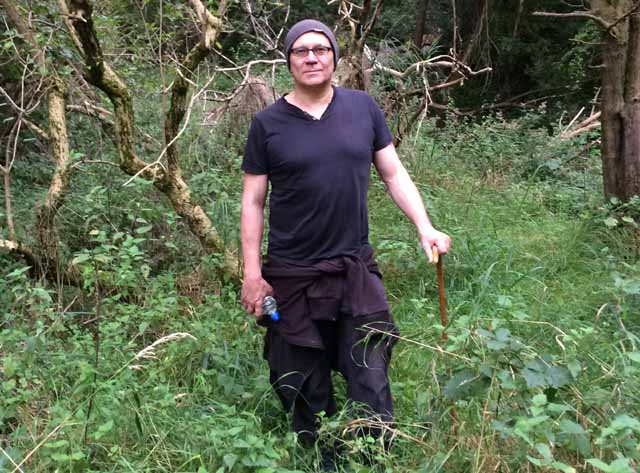
Andrew Collins at St Helen's Well, Thetford, in September 2016, gaining inspiration for his new book (pic credit: Maria Smith).
Andrew Collins Newsletter - October 2016
E
A R T H Q U E StTT N
E W S
Andrew
Collins at St Helen's Well, Thetford, in September 2016, gaining inspiration for
his new book (pic credit: Maria Smith).
Andrew
Collins Newsletter - October 2016
In this issue: Origins 2016 Update and Registration. Stunning tour planned to Armenia and Georgia in June 2017. Atlantis in the Caribbean - new book published and update. Mesolithic shaman's sanctuary discovered in Poland: links to Ursa Major, Swiderians and Gobekli Tepe
There is now just over six weeks till Origins 2016 - Britain's premier ancient mysteries conference - which takes place across the weekend of Saturday/Sunday November 12/13th. So it is time now to register. An incredible host of speakers will be talking on everything from the technology of the angels to King Arthur, the Egyptian Pyramids, the evolution of Stonehenge, the discovery of Atlantis, quantum entanglement, cosmic origins, psychic questing, the primal grimoire, the native American death journey, Olmec heads, and much more.
Click for a full list of the speakers, the subject of their lectures, and immediate registration.
The schedule will be revealed shortly, and this I will send to you when available.
Atlantis in the Caribbean
I have a new book published by Inner Traditions this coming month entitled Atlantis in the Caribbean and the Comet that Changed the World." It is a completely revised edition, with lengthy new introduction and afterword, of my 2000 book Gateway to Atlantis. It ably demonstrates that:
- Plato's knowledge of the destruction of Atlantis came from Phoenician and Carthaginians journeys to the Western Atlantic seaboard, including the Bahamas and Caribbean
- Atlantis's central island as described by Plato was Cuba, its sunken lands being the former Bahaman landmass, as well as other areas of the Caribbean reclaimed by the sea shortly after the last ice age
- Its method of destruction was the comet impact of 10,800 BCE, and the subsequent rise in the sea-level caused by ice melt waters flowing into the Gulf of Mexico during the Younger Dryas event, ca. 10,800-9600 BCE
- Ample evidence of underwater archaeological remains exist off the coasts of various Bahaman islands, as well as evidence of human activity in drowned caves within the Bahamas, showing that the former landmass was occupied thousands of years before the first official inhabitants arrived here from Cuba ca. 500-600 AD
All pretty standard stuff really, although it is surely a far cry from the old adage that Atlantis is the memory of the destruction of Minoan Crete due to the eruption of Santorini some 3,500 years ago. To argue this theory historians and sceptics have had to persuade us that Plato got all his dates wrong, he wrongly estimated the size of his island continent, and wrongly located the Pillars of Hercules and the Atlantic ocean. Now we don't have to invoke such crap to ably demonstrate that Plato actually got it right, and that Atlantis really was located on the western Atlantic seaboard and was drowned, finally, ca. 10,800-9600 BC.
I also exclusively reveal the full story behind the discovery of the Cuban underwater structures by ADC Communications in 2000, and what I think about the matter today, and I am not kind, in all honesty.
There is also a detailed assessment of the recent discovery in shallow water, south of the island of Bimini, of an archaeological ruin of great significance known today as Brown's Ruins. Today it is merely a strewn field of huge blocks made of blue schist, spread out like a fan towards the south. However, enough can be seen to suggest that this was perhaps a built structure that suffered the impact of an almighty tsunami at some point in the distant past. My colleagues Greg and Lora Little have dived the site on several occasions, and Lora will bring you a full report on their findings within her exclusive UK lecture at Origins 2016. Greg, whose own work with Lora investigating the underwater structures located in Bahaman waters was inspired in part through reading my book Gateway to Atlantis, has this to say about Atlantis in the Caribbean:
"Collins has compiled the most thoughtful, comprehensive, and rational book ever written on the controversial topic of Atlantis."
Anyway, you can get Atlantis in the Caribbean now from Amazon and Barnes and Noble. I guarantee you will not be disappointed with the in depth research I have conducted into this subject.
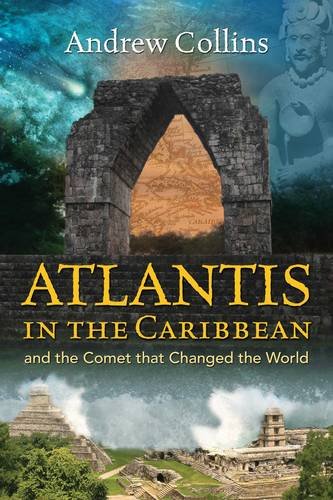
Cover
of Atlantis in the Caribbean by Andrew Collins
Tour
Expedition to Armenia and Georgia
From June 1st to June 11th 2017 Hugh Newman and I embark on a tour of Armenia and Georgia (with add ons to Gobekli Tepe and eastern Turkey, May 29-June 1st), which will explore the prehistoric, ancient and most sacred places of these countries.
Among the sites to be visited in Armenia are the Dvin pyramid, Agarak carved caves, Portasar "Naval" Stone, Karahunj "Armenia's Stonehenge," Hartashen megalithic avenue, Metsamor observatory and various rock cut churches. In Georgia we visit the Khervisi Fortress, megalithic ruins at Saro, Uplistsikhe cave town, Vardzia cave town, Narikala Fortress, and various other sites as well.
Obviously, Karahunj is top of the list of sites to be visited in Armenia, especially as the layout of this incredible megalithic complex is thought to resemble the shape of the Cygnus constellation in its guise as a vulture, angegh in Armenian, which is the form Cygnus takes in Armenian star lore. Compounding the Cygnus link is that the site is believed to be aligned to the Cygnus star Deneb (and click here for my take on the subject).
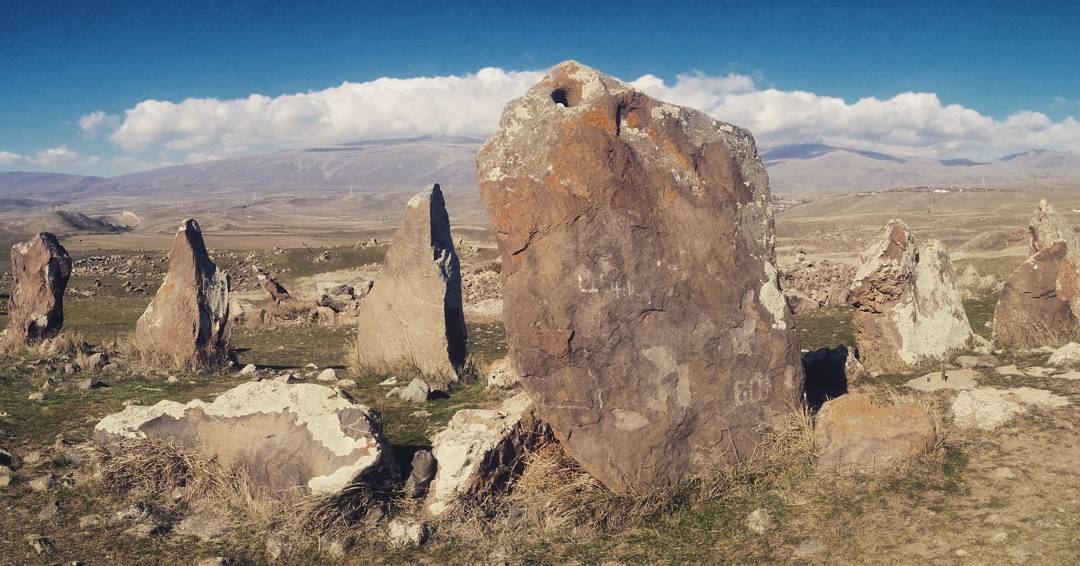
Karahunj
in Armenia. Its stones are laid out to resemble the star pattern made by the Cygnus
constellation (pic credit: Wiki Commons Agreement, 2016).
I propose that the main installations at Gobekli Tepe are aligned to the setting of the Cygnus star Deneb, something that has been confirmed independently by Italian academics working in the field of archaeoastronomy. Armenia borders eastern Turkey, so a relationship between the Gobekli builders and those who built Karahunj, arguably as early as 5500 BC, seems likely indeed.
Before the main tour starts on June 1st there is the opportunity to visit Eastern Turkey, and see various key sites in this part of the country including Lake Van and the Urartian megalithic fortress of Cuvestepe. Even before that on May 27th-29th there is a second add-on, which will give people the opportunity to see Gobekli Tepe, Karahan Tepe, and the various sites of Sanliurfa. They include the Pools of Abraham and the archaeological museum with its fabulous reconstruction of one of the main enclosures at Gobekli Tepe, as well as the cult building of Nevali Cori, and its collection of many thousands of objects dating from the Palaeolithic age through to the Islamic age.
Please note that the two add ons to Turkey are optional and not part of the main tour, which does NOT enter Turkey at any point.
The tour includes quality hotels, most meals, entrance to sites, local flights, ground transport, English speaking guides (but does not include international flights, trip insurance, drinks and tips).
Click for full details and immediate registration using paypal or click the flyer.
Shaman's
Camp Found in Poland
Archaeologists from the Institute of Archaeology and Ethnology in Poland have uncovered a shaman's cult structure on the edge of an ancient lake at Bolków by Lake Swidwie, Western Pomerania, in that country.
The structure, which has a diameter of around 6 metres and dates back to the Mesolithic age, ca. 7000 BC, has produced a number of different objects that suggest the site was ritualistic in nature. They include the fragment of a meteorite (which is thought to be shaped like the body and wings of a bird - see figure), as well as seven yew stakes (see figure) that were found piled into the ground in the characteristic shape of the seven main stars of Ursa Major, the Great Bear. This has led archaeologists to propose that shamans played an important role in Mesolithic society, and also employed the use of a basic cosmology focused on the movement of the stars, and the patterns they make in the night sky.
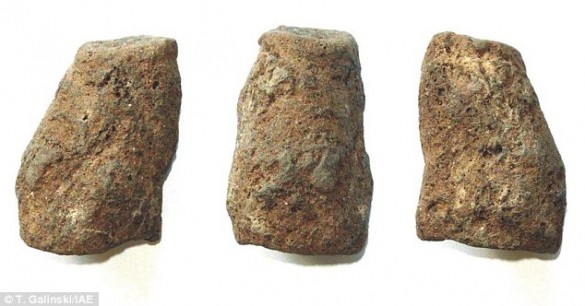
The
fragment of a meteorite found at the shaman's sanctuary at Bolków by Lake
Swidwie. Earlier reports suggested that it was carved into the shape of a bird's
body (pic credit: T. Galinski/IAE, 2014).
In addition to the meteorite and seven yew stakes, the sanctuary revealed various other items that confirm its ritual usage. They include a wooden censer (see figure), used perhaps for ritual cleansing or even to aid the inducement of altered states of consciousness. There was also a bundle consisting of pieces of wood, bark, herbaceous plants and animal bones, which has been interpreted as an offering of some kind.
According to Professor Tadeusz Galinski, lead excavator at Bolkow, "Sacrificial offering were an expression of belief in supernatural powers and forces of nature. Their purpose was to appease deities. They were made on behalf of all residents and members of the group with the participation of the spiritual leader."
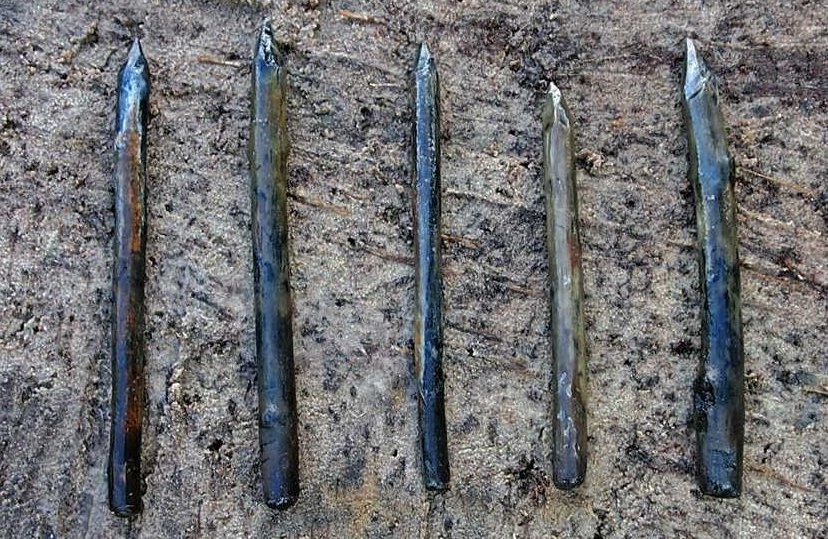
Yew
stakes found in the shaman's sanctuary at Bolków close to Lake Swidwie,
which had been piled into the ground in the shape of the seven main stars of Ursa
Major (pic credit: T. Galinski/IAE, 2014).
A
number of exotic minerals were also found within the sanctuary confines. They
included syenite, diorite, granite, quartzite, sandstone and gneiss, along with
rare Pomerania red marble and green syenite. In addition to this the archaeologists
retrieved pieces of jet, also known as black amber, as well as fragments of the
volcanic rock pumice. Presumably these different stones would have had different
meanings and functions to the practising shaman or shamaness.
"This
extraordinarily rich collection of stones is unique among the previously known
Mesolithic sites, located both within the vast European Plain, and in the zone
of the foothills and highlands," Galinki has stated. "These stones had
to be brought to the site in Bolków, and not only from the surrouding area
… but also from distant lands, the best example of which is hornfels, which
occurs closest in the Giant Mountains and the Harz Mountains."
In
addition to the exotic stones found, Galinski's team also recovered objects made
of wood, antler and stone, all of which were interpreted as part of a shaman's
kit. This included a cane of unusual shape, a wooden pendant, as well as an object
fashioned from birch bark, seen as the fragment of a ritual mask.
The sanctuary and the finds associated with the site is the subject of a paper written by Tadeusz Galinski and published in the latest issue of Archeologia Polski (no. 60, 2015). It's written in Polish, with a secondary English title of "Shaman sanctuary from the Mesolithic period in Bolków on the lake Swidwie in Pomerania".
Even though the article contains a full account of the discoveries made during the 2013-4 season, scientists are still working at the site and expect even more revelations to come from current excavations.
I did try and order the issue of Archeologia Polski in question, although I found this impossible to do from the UK. If anyone does manage to obtain a copy of the article, I would appreciate a copy.
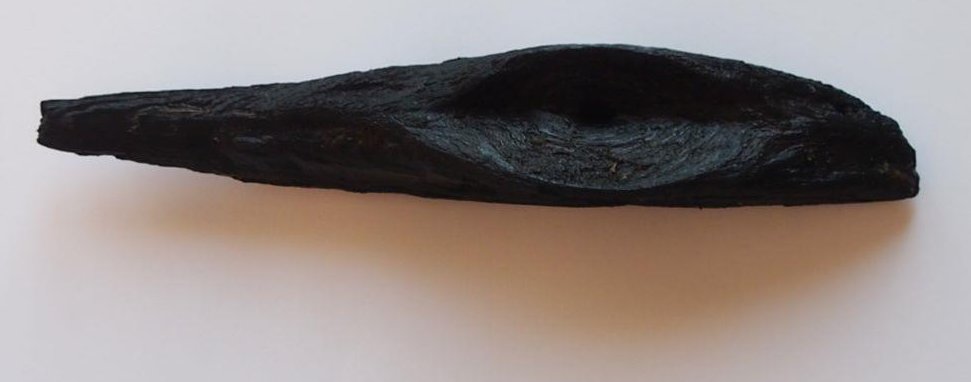
Censing
spoon found in the Mesolithic shaman's sanctuary at Bolków in Poland(pic
credit: T. Galinski/IAE, 2014).
Swiderian link
It should be pointed out that Bolków, which is situated on the left bank of the River Oder, on the southern border of the Wkra Forest, some 25 kilometres northwest of Szczecin, was also the site of a much earlier Epipalaeolithic culture known as the Ahrensburgian. They thrived here before and during the Younger Dryas event, ca. 10,800-9600 BC. These reindeer hunters were related to the Swiderians, who I propose in Gobekli Tepe: Genesis of the Gods were influential in the construction of Gobekli Tepe's earliest enclosures ca. 9600-9000 BCE.
Almost certainly there is a relationship between the shamanic beliefs and practices associated with Bolków's Mesolithic shaman's sanctuary and those that prevailed at Gobekli Tepe in the second half of the tenth millennium BC. So to find that the Bolków sanctuary has revealed very specific evidence that the stars of the northern night sky were revered at the site strengthens the idea that this area of the sky was also important to the Gobekli builders.
Cambodia and Java Tour
If you fancy joining Hugh Newman of Megalithomania and myself in Cambodia and Java in March 2017, why not check out this upcoming tour we have arranged in concert with Travel the Unknown. It takes in various sites in the Angkor Wat area, including all the major temples. We will also visit the Hindu-Buddhist temple complex of Preah Vihear, where you will see a style of megalithic architecture in one structure unlike any of the other buildings. A case can be made for this structure dating back to an earlier age of activity at the site.
From Cambodia we shall be travelling on to Java, where you will see the megalithic complex of Gudung Padang, which could easily be pre-8000 BC in origin. Our guide for the tour of the site will be geologist Danny Hilman, who has done such great work bringing the previously unknown core architecture of Gudung Padang to the notice of the archaeological world. We shall also visit the incredible Hindu-Buddhist temple complex of Borobudur as well as various other key sites, including the location where one of our earliest ancestors, Java Man, was found by anthropologist Eugène Dubois in 1891.
Click for more information on this unique tour to Cambodia and Java.